by Leland Teschler, Executive Editor
Once ignored by legislators, fractional horsepower motors now must adhere to energy efficiency regulations.
Get ready for the Dept. of Energy’s Small Motor Rule (SMR). This is a new regulation taking effect in March 2015 that is designed to raise the efficiency level of small electric motors, two-digit NEMA frame single- and three-phase general-purpose motors in the range of 0.25 to 3 hp that are housed in open drip-proof enclosures.
Energy efficiency regulations are a new phenomenon for small motors, but not for big ones. The U.S. began regulating the efficiency of integral horsepower motors beginning with the Energy Policy Act (EPAct) of 1992. Ensuing EPAct legislation in 2005 and the Energy Independence and Security Act (EISA) legislation in 2007 expanded the types of motors covered and ushered in more stringent minimum efficiencies for them.
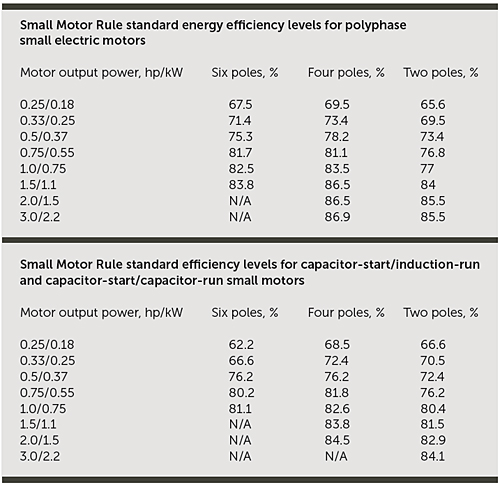
DoE regulators focused initially on larger electric motors simply because larger models accounted for the bulk of the energy consumed by all motors in the U.S. With efficiency levels of large motors now under control, emphasis has shifted to the more complicated small motor area. Complications arise because small motors can be designed in a variety of topologies. Some, for example, may build in magnets to boost efficiency and assist with rotation. Others can employ electronic controls to tweak efficiency levels. But some designs, such as shaded pole motors and some capacitor-start models, may go the way of the buggy whip because their efficiency is unlikely to be improved to the degree the DoE requires.
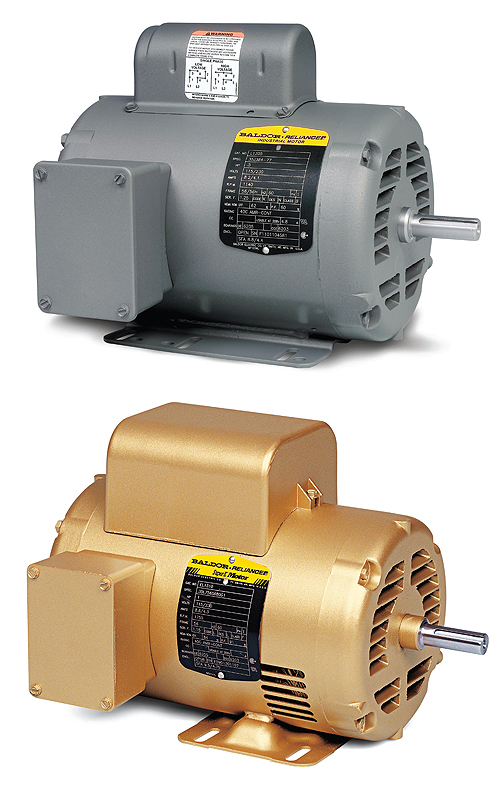
Motors, before (gray) and after (gold) the Small Motor Rule. Both are made by Baldor Electric Co. The pre-rule motor is a capacitor start—induction run design. To raise the efficiency, Baldor added more active material and switched to lower-loss, high-grade electrical steel and changed over to a design using a capacitor start—capacitor run scheme.
The minimum efficiency standard levels apply to all small electric motors made for sale in the U.S. or imported into the U.S. as stand-alone items or as part of a system.
Small motor regs
The small motors covered by the SMR are designated not just by horsepower rating, but also by frame size. Therein can lie confusion.
The term “fractional horsepower” refers to motors having frame sizes with two-digit designations as opposed to the three-digit designations that apply to many (but not all) integral horsepower motors. The frame sizes that are normally associated with industrial fractional horsepower motors are 42, 48 and 56. (As a quick review, each frame size designates a particular shaft height, shaft diameter, and face or base mounting hole pattern.)
A point to note is that a motor of a given horsepower and speed might be available in three different frame sizes. The two-digit frame number is based on the shaft height in sixteenths of an inch; a motor in a 48 frame will have a shaft height of 48 divided by 16, or 3 in. Similarly, a 56-frame motor would have a shaft height of 3.5 in. The largest fractional horsepower frame size is a 56, but it can house motors having horsepowers exceeding those normally associated with fractional motors. For example, 56-frame motors can have horsepowers up to 3 and sometimes 5 hp.
That is something to keep in mind when reviewing SMR provisions, which cover two-digit frame motors and motors having IEC-equivalent frame sizes. The SMR also covers two-, four- and six-pole designs from 1/4 to 3 hp. Covered as well are open construction motors that are either three-phase, capacitor start-induction run or capacitor start/capacitor run designs. And the SMR covers motors that are rated for continuous duty and also meet NEMA Service Factor provisions.
There are still a few exceptions for the Rule. It doesn’t apply to definite or special purpose open construction designs, motors operating at speeds outside those of two-, four- or six-pole motors, enclosed motors, motor types that are not classified as being three-phase, cap start-induction run or cap start/cap run, intermittent duty motors, and motors already covered by other efficiency legislation.
End users won’t need to replace machinery now in use, but replacement motors will have to meet the new efficiency levels.
Applications likely to be impacted by the new rules include those involving pumps and HVAC equipment. Single-phase capacitor-start motors are widely used in both settings. And indications are that the new regulations may affect some motor manufacturers more than others. Officials at Baldor Electric Co., for example, said some of their motors already exceed the efficiency levels spelled out under the new rule. But some kinds of motors will need to be redesigned before they can hit levels spelled out in the SMR efficiency tables.
“It is not easy to hit those levels,” said Baldor Electric Co. Senior Industry Affairs Manager John Malinowski. “Four-pole motors, for example, have to hit efficiency levels above those of NEMA Premium, the level used for efficiency tables in EISA legislation. The difficulties involved in hitting those levels may be enough to make capacitor-start/induction run motors impractical. Applications for the those motors may have to transition to capacitor-start/capacitor-run.”
As a brief review, capacitor-start/capacitor-run motors have a capacitor in series with an auxiliary start winding and another capacitor in series with the stator winding. The capacitor in series with the auxiliary start winding lets the motor handle heavier start loads by strengthening the magnetic field of the start winding. The auxiliary start winding and start capacitor are both switched off (usually by a centrifugal switch) once rotor shaft speed reaches a predetermined level (about 80% of run speed).
The run capacitor in series with the stator winding performs a function similar to that of the start capacitor, but for the purpose of reducing running current rather than handling heavier loads. Thus capacitor-start/capacitor-run motors use less running current and are thus more energy efficient than capacitor-start/induction-run motors. But they cost more.
In addition, small motors meeting SMR requirements may be physically bigger than those that don’t. “Some motors may need a bigger body. The overall motor might be double the size of the less efficient model,” said Malinowski. The reason for the growth in dimensions is that these motors need more active material to gain efficiency. “The amount of active material, windings and electrical steel, might have to go up by 20%. The steel used will also have to be of a higher grade. This factor alone could add 20% to the cost of the motor, but the impact will vary depending on the motor involved,” said Malinowski.
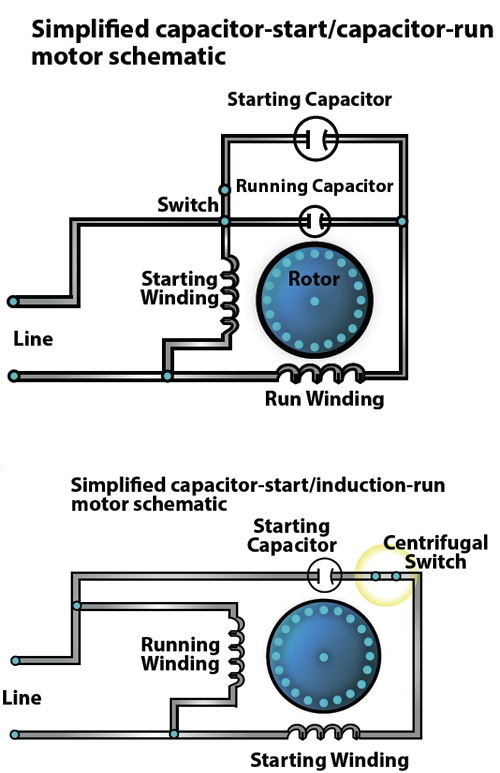
Both capacitor start/capacitor run and capacitor start / induction run motors employ a capacitor connected in series to start windings to maximize starting torque. A normally closed centrifugal switch sits between the capacitor and the start winding. The switch opens when the motor reaches about 80 % of its normal operating speed. The capacitor basically lets the motor handle heavier start loads by strengthening the magnetic field of the start windings. In capacitor run motors, a capacitor in series with the stator windings also strengthens the magnetic field, but for the purpose of running with less current rather than to boost motor torque. This lets capacitor-run motors be more energy efficient than equivalent induction-run units.
SMR-compliant motors will have benefits in addition to better energy efficiency. “In some cases they might have more starting torque, but it depends on how the motor is designed,” said Malinowski. “Though if they use more active material and run with less electrical saturation, the torque might not be affected.”
Malinowski also said motors incorporating steel-band housings could have challenges meeting the new efficiency levels—it’s difficult to raise the efficiency on these motors because the steel housing doesn’t dissipate heating losses as easily as cast iron housings.
Big motors
Small motors aren’t the only devices getting attention from the DoE. In May of 2014, DoE revised efficiency regulations for integral horsepower motors. Those new rules go into effect on June 1, 2016. The new legislation addresses a criticism of the earlier EISA measures: Motor manufacturers could get around them relatively easily. The reason was that both EISA and its EPAct predecessor covered mainly standard motors. To avoid compliance with these measures, manufacturers could simply make a “nonstandard” version of a stock motor, because the definition of “nonstandard” for the purposes of energy efficiency was loose. For example, producing a motor with a mounting scheme not spelled out in the regulations could make it exempt.
In 2016, these loopholes will have largely been plugged. New provisions cover NEMA design A and B motors from 201 to 500 hp; NEMA design C motors from 1 to 500 hp; motors working from all voltages less than 600 V; eight-pole motors; motors with non-standard endshields, flanges, or shafts; motors with moisture-resistant windings (like encapsulated or sealed windings); motors that use any non-standard mounting like a base or cradles; footless motors that do not have a base or cradle; partially designed motors that are not merely rotor or stator sets; vertical hollow-shaft motors; totally enclosed, not ventilated (TENV) designs; JM and JP pump motors (that is, those with mechanical seals); electric motors having thrust or roller bearings; integral brake motors, motors with separately cooled blowers; enclosed 56 frame motors of 1 hp and larger; and gearmotors where the motor can be removed from the reducer and can work as an independent motor.
All in all, far fewer variations of integral horsepower motors will be able to avoid efficiency regulations.
References:
U. S. Dept. of Energy, Small Motor Rule,
http://cms.doe.gov/articles/new-energy-efficiency-standards-electric-motors-and-walk-coolers-and-freezers-save-energy
Baldor Electric Co.
www.baldor.com/products/ac_motors.asp
Filed Under: ELECTRONICS • ELECTRICAL

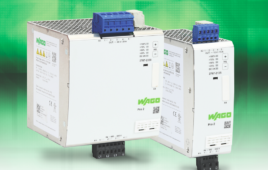

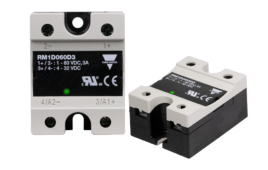
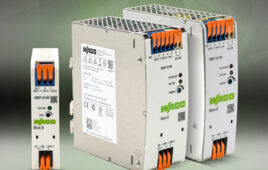
Is it compliant changing a win motor with a generic Pac motor?